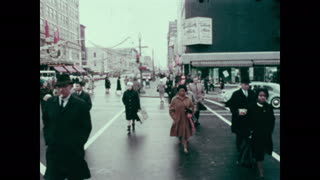“Space Down to Earth” is a circa 1970 NASA education film that explores how science impacts not only the exploration of space but also life on Earth. The color film begins with “sounds” from space — signals from satellites orbiting Earth — each of which have their own signature, or tone. Such application satellites serve many different functions, we are told, including weather, communications, and Earth resources. Beginning at mark 01:45, the narrator explains how satellites such as Nimbus and TIROS track weather conditions around the globe, including hurricanes, as we see scenes from 1969’s Hurricane Camille — a catastrophic Category 5 hurricane that struck the Gulf Coast of the United States. (TIROS, we’re told at mark 06:00, also carries equipment that can help spot solar flares). Satellites are also used in communications, we’re told starting at mark 09:30, with those communication satellites doing everything from assisting in telephone calls to providing cable television service. At mark 10:26 we hear the voice of President Dwight D. Eisenhower transmitted in 1960 as a part of Project Echo, a metalized balloon satellite. We also see visit to Mexico City by Pope Paul VI (mark 11:27) and of course images of Neil Armstrong and Buzz Aldrin on the lunar surface as part of the Apollo 11 mission (mark 11:32), and the crew of Apollo 13 (mark 11:48) after they narrowly escaped death and returned to Earth. Communication satellites are also used to aid aircraft and other transportation areas (mark 15:20), as we see jets taxi down the runway. By mark 19:50, the film focuses on the use of satellites on natural resources such as oceans and other waterways and how they are impacted by pollution. Satellites can also track a variety of geographic features and compare the data for any environmental changes. As it approaches its conclusion, the film teases Skylab (mark 24:53), a United States space station. Still a few years away from launch at the time of the film, the film interviews astronaut William Lenoir at mark 25:13. (Lenoir had hoped to fly on Skylab but only served as a member of a back-up crew on two missions). In his interview, he touts the importance of satellites and their benefits in studying the planet’s resources.
47604 NASA SPACE DOWN TO EARTH 1970s SPACE EXPLORATION & SATELLITES ECHO TIROS APOLLO PROGRAM

About Us
Thanks for your interest in the Periscope Film stock footage library. We maintain one of the largest collections of historic military, aviation and transportation in the USA. We provide free research and can provide viewing copies if you can let us know some of the specific types of material you are looking for. Almost all of our materials are available in high quality 24p HD ProRes and 2k/4k resolution.
Our material has been licensed for use by:

